Young People and Voting Participation
VerifiedAdded on 2020/03/01
|9
|2304
|35
AI Summary
This assignment delves into the participation of young people in the voting process within New Zealand. It analyzes various factors affecting their voting behavior, drawing upon data from sources like the Electoral Commission and academic studies. The text explores the reasons behind low voter turnout among youth and examines potential solutions to encourage greater engagement.
Contribute Materials
Your contribution can guide someone’s learning journey. Share your
documents today.
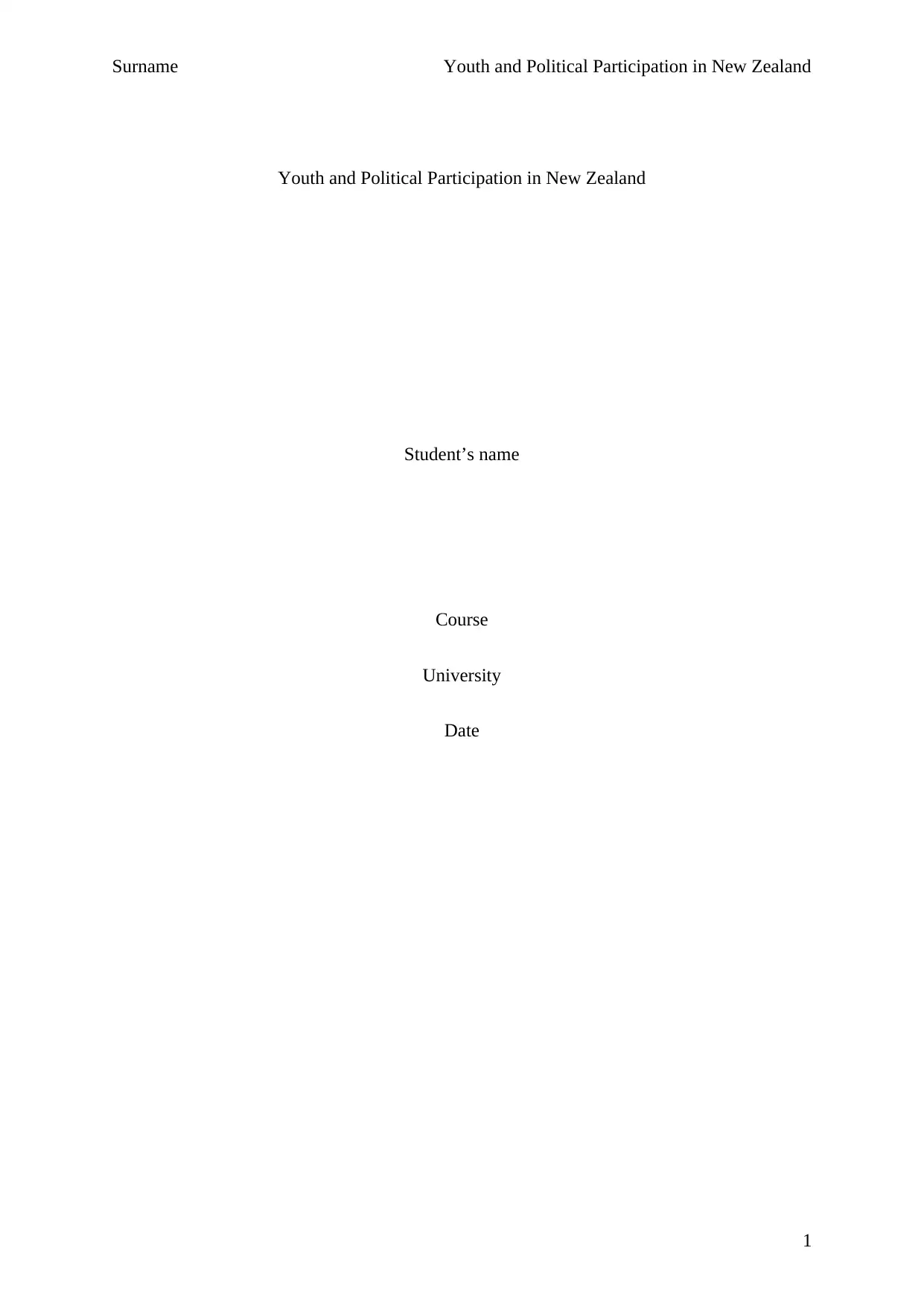
Surname Youth and Political Participation in New Zealand
Youth and Political Participation in New Zealand
Student’s name
Course
University
Date
1
Youth and Political Participation in New Zealand
Student’s name
Course
University
Date
1
Secure Best Marks with AI Grader
Need help grading? Try our AI Grader for instant feedback on your assignments.
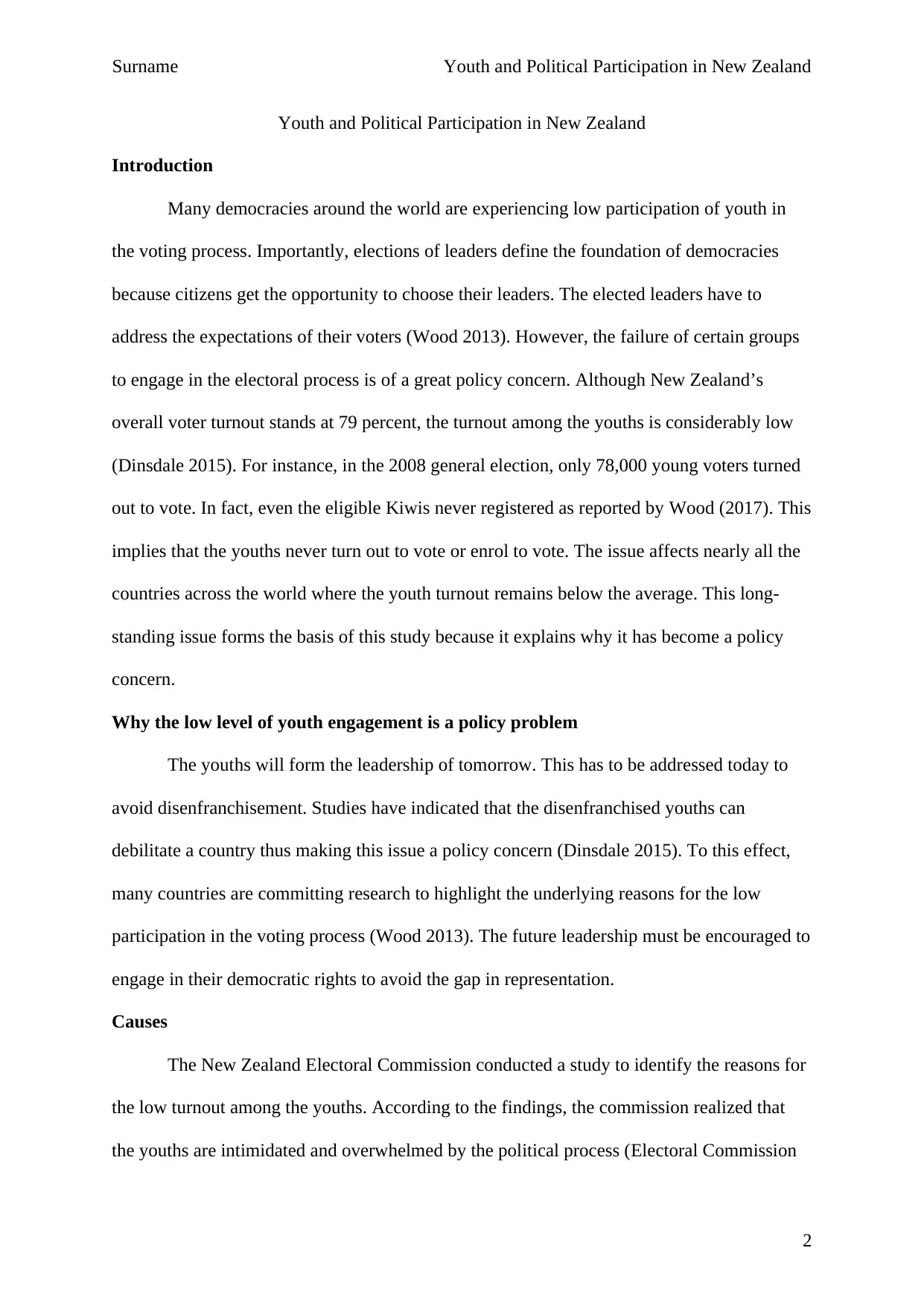
Surname Youth and Political Participation in New Zealand
Youth and Political Participation in New Zealand
Introduction
Many democracies around the world are experiencing low participation of youth in
the voting process. Importantly, elections of leaders define the foundation of democracies
because citizens get the opportunity to choose their leaders. The elected leaders have to
address the expectations of their voters (Wood 2013). However, the failure of certain groups
to engage in the electoral process is of a great policy concern. Although New Zealand’s
overall voter turnout stands at 79 percent, the turnout among the youths is considerably low
(Dinsdale 2015). For instance, in the 2008 general election, only 78,000 young voters turned
out to vote. In fact, even the eligible Kiwis never registered as reported by Wood (2017). This
implies that the youths never turn out to vote or enrol to vote. The issue affects nearly all the
countries across the world where the youth turnout remains below the average. This long-
standing issue forms the basis of this study because it explains why it has become a policy
concern.
Why the low level of youth engagement is a policy problem
The youths will form the leadership of tomorrow. This has to be addressed today to
avoid disenfranchisement. Studies have indicated that the disenfranchised youths can
debilitate a country thus making this issue a policy concern (Dinsdale 2015). To this effect,
many countries are committing research to highlight the underlying reasons for the low
participation in the voting process (Wood 2013). The future leadership must be encouraged to
engage in their democratic rights to avoid the gap in representation.
Causes
The New Zealand Electoral Commission conducted a study to identify the reasons for
the low turnout among the youths. According to the findings, the commission realized that
the youths are intimidated and overwhelmed by the political process (Electoral Commission
2
Youth and Political Participation in New Zealand
Introduction
Many democracies around the world are experiencing low participation of youth in
the voting process. Importantly, elections of leaders define the foundation of democracies
because citizens get the opportunity to choose their leaders. The elected leaders have to
address the expectations of their voters (Wood 2013). However, the failure of certain groups
to engage in the electoral process is of a great policy concern. Although New Zealand’s
overall voter turnout stands at 79 percent, the turnout among the youths is considerably low
(Dinsdale 2015). For instance, in the 2008 general election, only 78,000 young voters turned
out to vote. In fact, even the eligible Kiwis never registered as reported by Wood (2017). This
implies that the youths never turn out to vote or enrol to vote. The issue affects nearly all the
countries across the world where the youth turnout remains below the average. This long-
standing issue forms the basis of this study because it explains why it has become a policy
concern.
Why the low level of youth engagement is a policy problem
The youths will form the leadership of tomorrow. This has to be addressed today to
avoid disenfranchisement. Studies have indicated that the disenfranchised youths can
debilitate a country thus making this issue a policy concern (Dinsdale 2015). To this effect,
many countries are committing research to highlight the underlying reasons for the low
participation in the voting process (Wood 2013). The future leadership must be encouraged to
engage in their democratic rights to avoid the gap in representation.
Causes
The New Zealand Electoral Commission conducted a study to identify the reasons for
the low turnout among the youths. According to the findings, the commission realized that
the youths are intimidated and overwhelmed by the political process (Electoral Commission
2
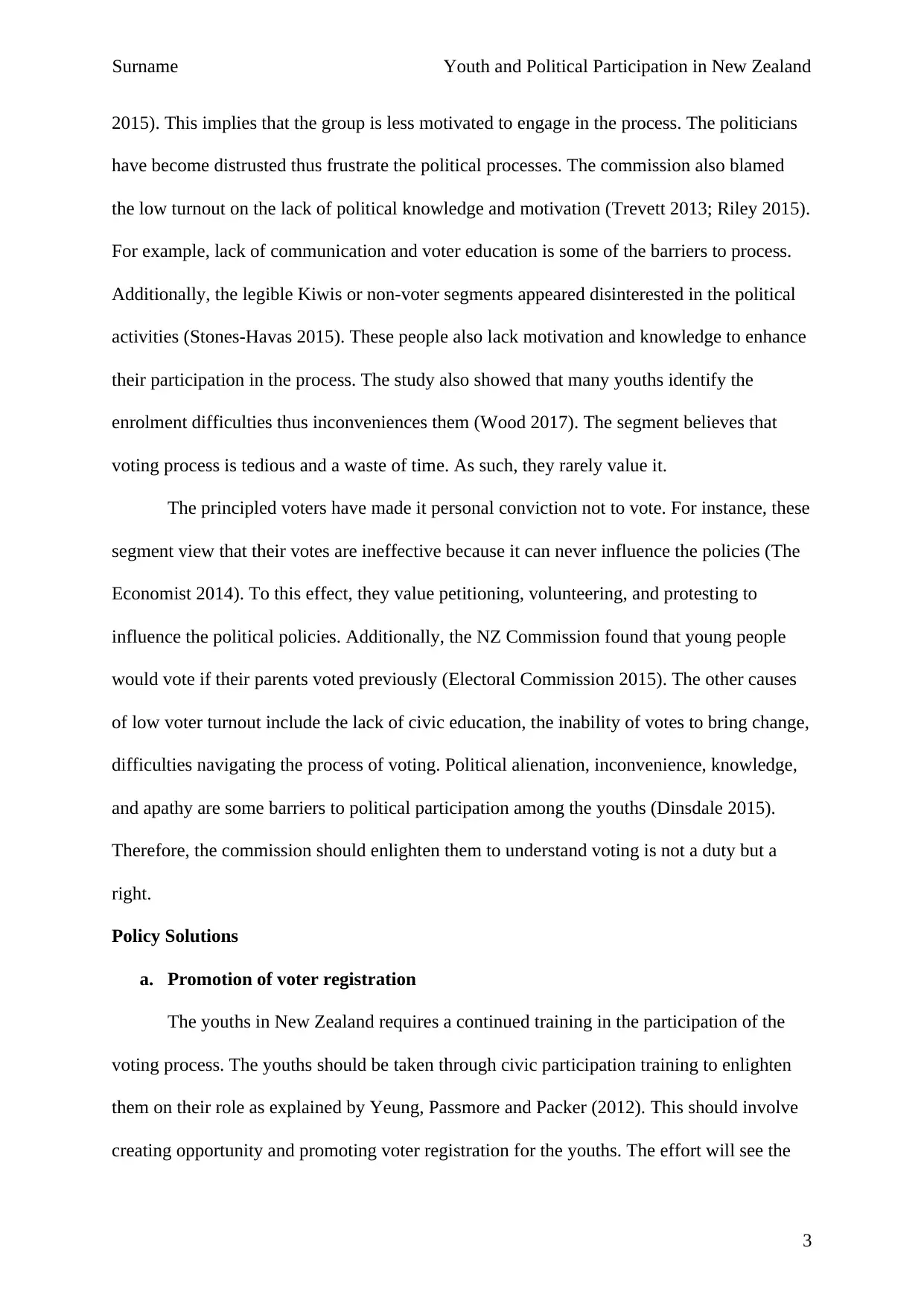
Surname Youth and Political Participation in New Zealand
2015). This implies that the group is less motivated to engage in the process. The politicians
have become distrusted thus frustrate the political processes. The commission also blamed
the low turnout on the lack of political knowledge and motivation (Trevett 2013; Riley 2015).
For example, lack of communication and voter education is some of the barriers to process.
Additionally, the legible Kiwis or non-voter segments appeared disinterested in the political
activities (Stones-Havas 2015). These people also lack motivation and knowledge to enhance
their participation in the process. The study also showed that many youths identify the
enrolment difficulties thus inconveniences them (Wood 2017). The segment believes that
voting process is tedious and a waste of time. As such, they rarely value it.
The principled voters have made it personal conviction not to vote. For instance, these
segment view that their votes are ineffective because it can never influence the policies (The
Economist 2014). To this effect, they value petitioning, volunteering, and protesting to
influence the political policies. Additionally, the NZ Commission found that young people
would vote if their parents voted previously (Electoral Commission 2015). The other causes
of low voter turnout include the lack of civic education, the inability of votes to bring change,
difficulties navigating the process of voting. Political alienation, inconvenience, knowledge,
and apathy are some barriers to political participation among the youths (Dinsdale 2015).
Therefore, the commission should enlighten them to understand voting is not a duty but a
right.
Policy Solutions
a. Promotion of voter registration
The youths in New Zealand requires a continued training in the participation of the
voting process. The youths should be taken through civic participation training to enlighten
them on their role as explained by Yeung, Passmore and Packer (2012). This should involve
creating opportunity and promoting voter registration for the youths. The effort will see the
3
2015). This implies that the group is less motivated to engage in the process. The politicians
have become distrusted thus frustrate the political processes. The commission also blamed
the low turnout on the lack of political knowledge and motivation (Trevett 2013; Riley 2015).
For example, lack of communication and voter education is some of the barriers to process.
Additionally, the legible Kiwis or non-voter segments appeared disinterested in the political
activities (Stones-Havas 2015). These people also lack motivation and knowledge to enhance
their participation in the process. The study also showed that many youths identify the
enrolment difficulties thus inconveniences them (Wood 2017). The segment believes that
voting process is tedious and a waste of time. As such, they rarely value it.
The principled voters have made it personal conviction not to vote. For instance, these
segment view that their votes are ineffective because it can never influence the policies (The
Economist 2014). To this effect, they value petitioning, volunteering, and protesting to
influence the political policies. Additionally, the NZ Commission found that young people
would vote if their parents voted previously (Electoral Commission 2015). The other causes
of low voter turnout include the lack of civic education, the inability of votes to bring change,
difficulties navigating the process of voting. Political alienation, inconvenience, knowledge,
and apathy are some barriers to political participation among the youths (Dinsdale 2015).
Therefore, the commission should enlighten them to understand voting is not a duty but a
right.
Policy Solutions
a. Promotion of voter registration
The youths in New Zealand requires a continued training in the participation of the
voting process. The youths should be taken through civic participation training to enlighten
them on their role as explained by Yeung, Passmore and Packer (2012). This should involve
creating opportunity and promoting voter registration for the youths. The effort will see the
3
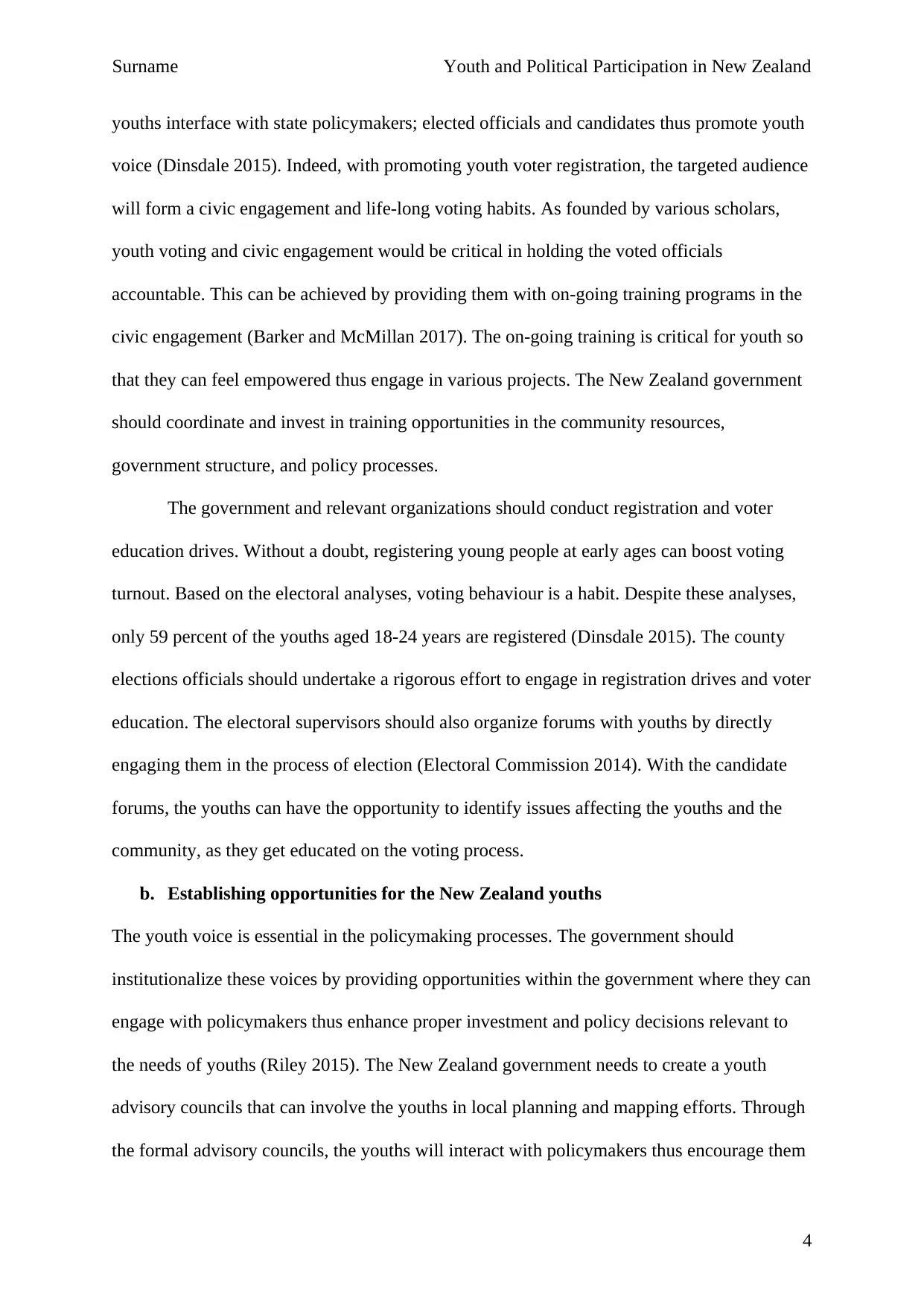
Surname Youth and Political Participation in New Zealand
youths interface with state policymakers; elected officials and candidates thus promote youth
voice (Dinsdale 2015). Indeed, with promoting youth voter registration, the targeted audience
will form a civic engagement and life-long voting habits. As founded by various scholars,
youth voting and civic engagement would be critical in holding the voted officials
accountable. This can be achieved by providing them with on-going training programs in the
civic engagement (Barker and McMillan 2017). The on-going training is critical for youth so
that they can feel empowered thus engage in various projects. The New Zealand government
should coordinate and invest in training opportunities in the community resources,
government structure, and policy processes.
The government and relevant organizations should conduct registration and voter
education drives. Without a doubt, registering young people at early ages can boost voting
turnout. Based on the electoral analyses, voting behaviour is a habit. Despite these analyses,
only 59 percent of the youths aged 18-24 years are registered (Dinsdale 2015). The county
elections officials should undertake a rigorous effort to engage in registration drives and voter
education. The electoral supervisors should also organize forums with youths by directly
engaging them in the process of election (Electoral Commission 2014). With the candidate
forums, the youths can have the opportunity to identify issues affecting the youths and the
community, as they get educated on the voting process.
b. Establishing opportunities for the New Zealand youths
The youth voice is essential in the policymaking processes. The government should
institutionalize these voices by providing opportunities within the government where they can
engage with policymakers thus enhance proper investment and policy decisions relevant to
the needs of youths (Riley 2015). The New Zealand government needs to create a youth
advisory councils that can involve the youths in local planning and mapping efforts. Through
the formal advisory councils, the youths will interact with policymakers thus encourage them
4
youths interface with state policymakers; elected officials and candidates thus promote youth
voice (Dinsdale 2015). Indeed, with promoting youth voter registration, the targeted audience
will form a civic engagement and life-long voting habits. As founded by various scholars,
youth voting and civic engagement would be critical in holding the voted officials
accountable. This can be achieved by providing them with on-going training programs in the
civic engagement (Barker and McMillan 2017). The on-going training is critical for youth so
that they can feel empowered thus engage in various projects. The New Zealand government
should coordinate and invest in training opportunities in the community resources,
government structure, and policy processes.
The government and relevant organizations should conduct registration and voter
education drives. Without a doubt, registering young people at early ages can boost voting
turnout. Based on the electoral analyses, voting behaviour is a habit. Despite these analyses,
only 59 percent of the youths aged 18-24 years are registered (Dinsdale 2015). The county
elections officials should undertake a rigorous effort to engage in registration drives and voter
education. The electoral supervisors should also organize forums with youths by directly
engaging them in the process of election (Electoral Commission 2014). With the candidate
forums, the youths can have the opportunity to identify issues affecting the youths and the
community, as they get educated on the voting process.
b. Establishing opportunities for the New Zealand youths
The youth voice is essential in the policymaking processes. The government should
institutionalize these voices by providing opportunities within the government where they can
engage with policymakers thus enhance proper investment and policy decisions relevant to
the needs of youths (Riley 2015). The New Zealand government needs to create a youth
advisory councils that can involve the youths in local planning and mapping efforts. Through
the formal advisory councils, the youths will interact with policymakers thus encourage them
4
Secure Best Marks with AI Grader
Need help grading? Try our AI Grader for instant feedback on your assignments.
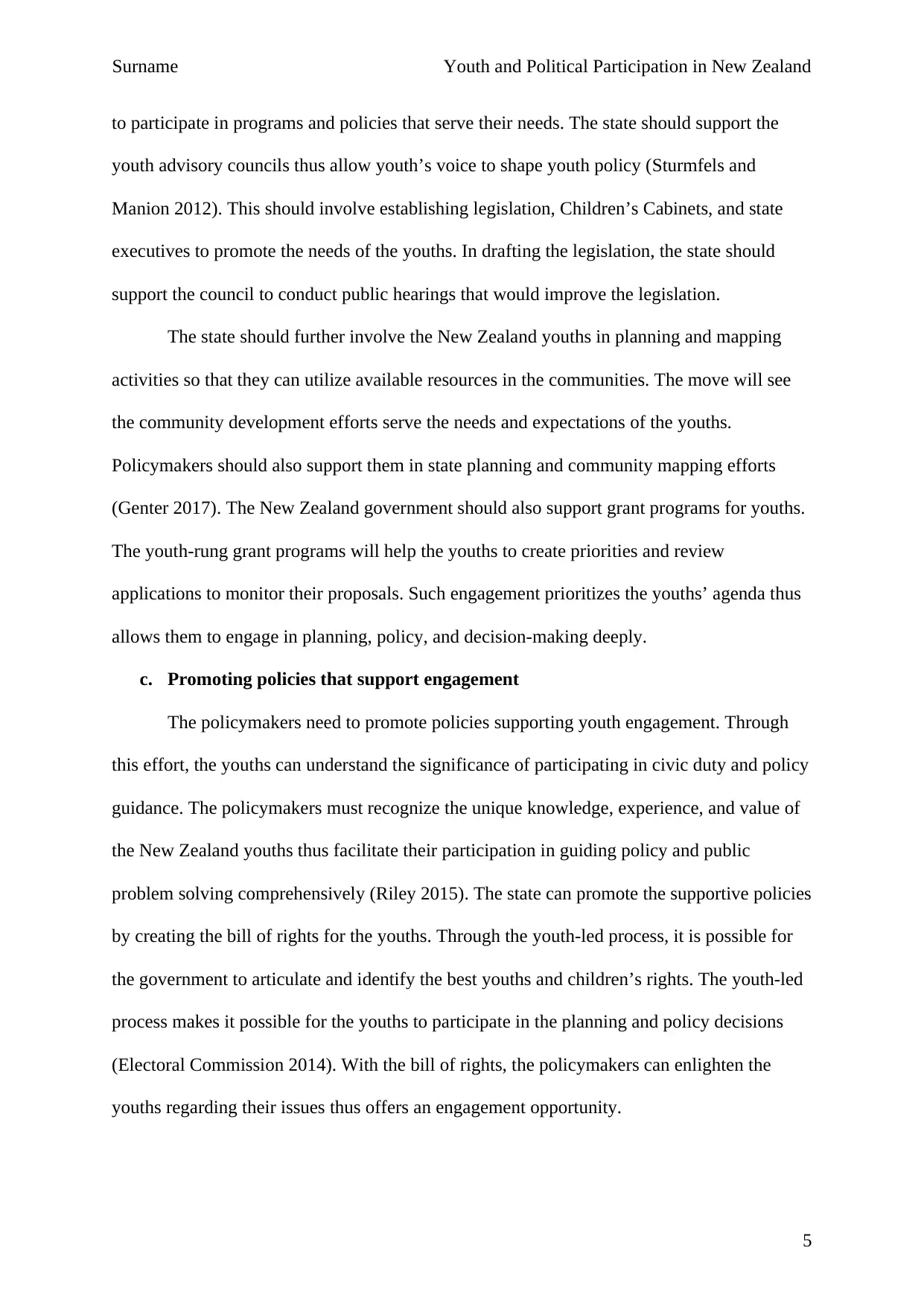
Surname Youth and Political Participation in New Zealand
to participate in programs and policies that serve their needs. The state should support the
youth advisory councils thus allow youth’s voice to shape youth policy (Sturmfels and
Manion 2012). This should involve establishing legislation, Children’s Cabinets, and state
executives to promote the needs of the youths. In drafting the legislation, the state should
support the council to conduct public hearings that would improve the legislation.
The state should further involve the New Zealand youths in planning and mapping
activities so that they can utilize available resources in the communities. The move will see
the community development efforts serve the needs and expectations of the youths.
Policymakers should also support them in state planning and community mapping efforts
(Genter 2017). The New Zealand government should also support grant programs for youths.
The youth-rung grant programs will help the youths to create priorities and review
applications to monitor their proposals. Such engagement prioritizes the youths’ agenda thus
allows them to engage in planning, policy, and decision-making deeply.
c. Promoting policies that support engagement
The policymakers need to promote policies supporting youth engagement. Through
this effort, the youths can understand the significance of participating in civic duty and policy
guidance. The policymakers must recognize the unique knowledge, experience, and value of
the New Zealand youths thus facilitate their participation in guiding policy and public
problem solving comprehensively (Riley 2015). The state can promote the supportive policies
by creating the bill of rights for the youths. Through the youth-led process, it is possible for
the government to articulate and identify the best youths and children’s rights. The youth-led
process makes it possible for the youths to participate in the planning and policy decisions
(Electoral Commission 2014). With the bill of rights, the policymakers can enlighten the
youths regarding their issues thus offers an engagement opportunity.
5
to participate in programs and policies that serve their needs. The state should support the
youth advisory councils thus allow youth’s voice to shape youth policy (Sturmfels and
Manion 2012). This should involve establishing legislation, Children’s Cabinets, and state
executives to promote the needs of the youths. In drafting the legislation, the state should
support the council to conduct public hearings that would improve the legislation.
The state should further involve the New Zealand youths in planning and mapping
activities so that they can utilize available resources in the communities. The move will see
the community development efforts serve the needs and expectations of the youths.
Policymakers should also support them in state planning and community mapping efforts
(Genter 2017). The New Zealand government should also support grant programs for youths.
The youth-rung grant programs will help the youths to create priorities and review
applications to monitor their proposals. Such engagement prioritizes the youths’ agenda thus
allows them to engage in planning, policy, and decision-making deeply.
c. Promoting policies that support engagement
The policymakers need to promote policies supporting youth engagement. Through
this effort, the youths can understand the significance of participating in civic duty and policy
guidance. The policymakers must recognize the unique knowledge, experience, and value of
the New Zealand youths thus facilitate their participation in guiding policy and public
problem solving comprehensively (Riley 2015). The state can promote the supportive policies
by creating the bill of rights for the youths. Through the youth-led process, it is possible for
the government to articulate and identify the best youths and children’s rights. The youth-led
process makes it possible for the youths to participate in the planning and policy decisions
(Electoral Commission 2014). With the bill of rights, the policymakers can enlighten the
youths regarding their issues thus offers an engagement opportunity.
5
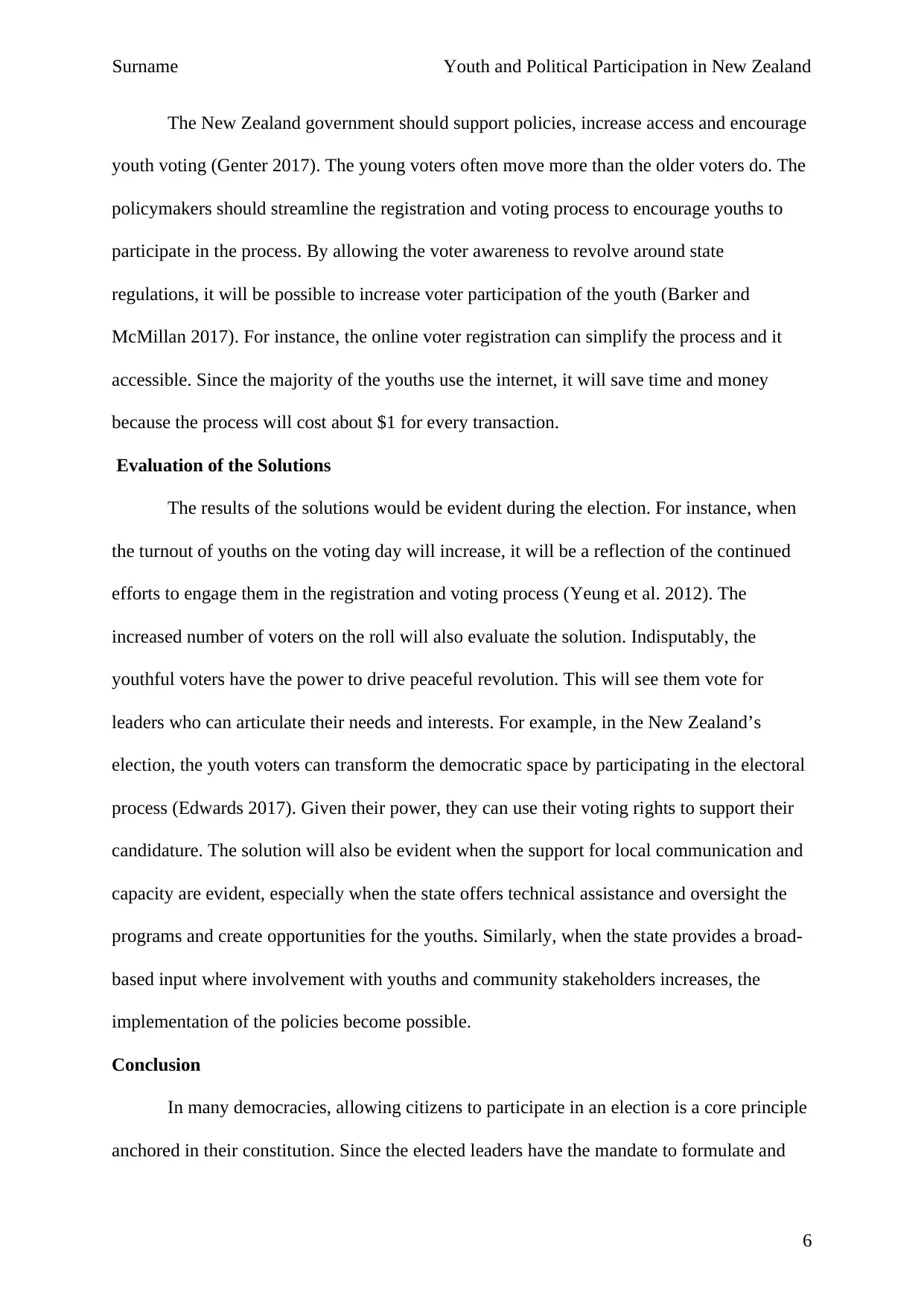
Surname Youth and Political Participation in New Zealand
The New Zealand government should support policies, increase access and encourage
youth voting (Genter 2017). The young voters often move more than the older voters do. The
policymakers should streamline the registration and voting process to encourage youths to
participate in the process. By allowing the voter awareness to revolve around state
regulations, it will be possible to increase voter participation of the youth (Barker and
McMillan 2017). For instance, the online voter registration can simplify the process and it
accessible. Since the majority of the youths use the internet, it will save time and money
because the process will cost about $1 for every transaction.
Evaluation of the Solutions
The results of the solutions would be evident during the election. For instance, when
the turnout of youths on the voting day will increase, it will be a reflection of the continued
efforts to engage them in the registration and voting process (Yeung et al. 2012). The
increased number of voters on the roll will also evaluate the solution. Indisputably, the
youthful voters have the power to drive peaceful revolution. This will see them vote for
leaders who can articulate their needs and interests. For example, in the New Zealand’s
election, the youth voters can transform the democratic space by participating in the electoral
process (Edwards 2017). Given their power, they can use their voting rights to support their
candidature. The solution will also be evident when the support for local communication and
capacity are evident, especially when the state offers technical assistance and oversight the
programs and create opportunities for the youths. Similarly, when the state provides a broad-
based input where involvement with youths and community stakeholders increases, the
implementation of the policies become possible.
Conclusion
In many democracies, allowing citizens to participate in an election is a core principle
anchored in their constitution. Since the elected leaders have the mandate to formulate and
6
The New Zealand government should support policies, increase access and encourage
youth voting (Genter 2017). The young voters often move more than the older voters do. The
policymakers should streamline the registration and voting process to encourage youths to
participate in the process. By allowing the voter awareness to revolve around state
regulations, it will be possible to increase voter participation of the youth (Barker and
McMillan 2017). For instance, the online voter registration can simplify the process and it
accessible. Since the majority of the youths use the internet, it will save time and money
because the process will cost about $1 for every transaction.
Evaluation of the Solutions
The results of the solutions would be evident during the election. For instance, when
the turnout of youths on the voting day will increase, it will be a reflection of the continued
efforts to engage them in the registration and voting process (Yeung et al. 2012). The
increased number of voters on the roll will also evaluate the solution. Indisputably, the
youthful voters have the power to drive peaceful revolution. This will see them vote for
leaders who can articulate their needs and interests. For example, in the New Zealand’s
election, the youth voters can transform the democratic space by participating in the electoral
process (Edwards 2017). Given their power, they can use their voting rights to support their
candidature. The solution will also be evident when the support for local communication and
capacity are evident, especially when the state offers technical assistance and oversight the
programs and create opportunities for the youths. Similarly, when the state provides a broad-
based input where involvement with youths and community stakeholders increases, the
implementation of the policies become possible.
Conclusion
In many democracies, allowing citizens to participate in an election is a core principle
anchored in their constitution. Since the elected leaders have the mandate to formulate and
6
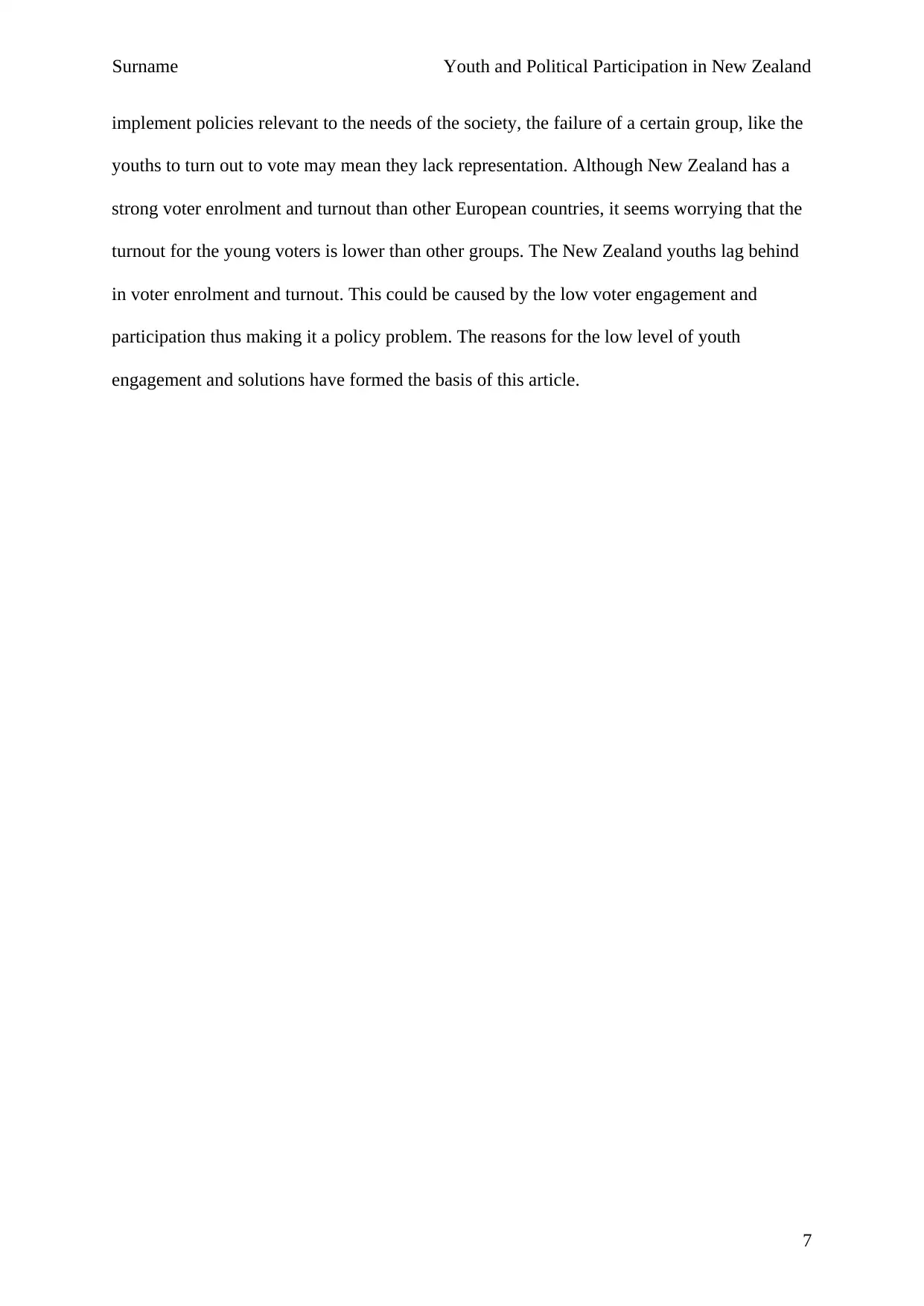
Surname Youth and Political Participation in New Zealand
implement policies relevant to the needs of the society, the failure of a certain group, like the
youths to turn out to vote may mean they lack representation. Although New Zealand has a
strong voter enrolment and turnout than other European countries, it seems worrying that the
turnout for the young voters is lower than other groups. The New Zealand youths lag behind
in voter enrolment and turnout. This could be caused by the low voter engagement and
participation thus making it a policy problem. The reasons for the low level of youth
engagement and solutions have formed the basis of this article.
7
implement policies relevant to the needs of the society, the failure of a certain group, like the
youths to turn out to vote may mean they lack representation. Although New Zealand has a
strong voter enrolment and turnout than other European countries, it seems worrying that the
turnout for the young voters is lower than other groups. The New Zealand youths lag behind
in voter enrolment and turnout. This could be caused by the low voter engagement and
participation thus making it a policy problem. The reasons for the low level of youth
engagement and solutions have formed the basis of this article.
7
Paraphrase This Document
Need a fresh take? Get an instant paraphrase of this document with our AI Paraphraser
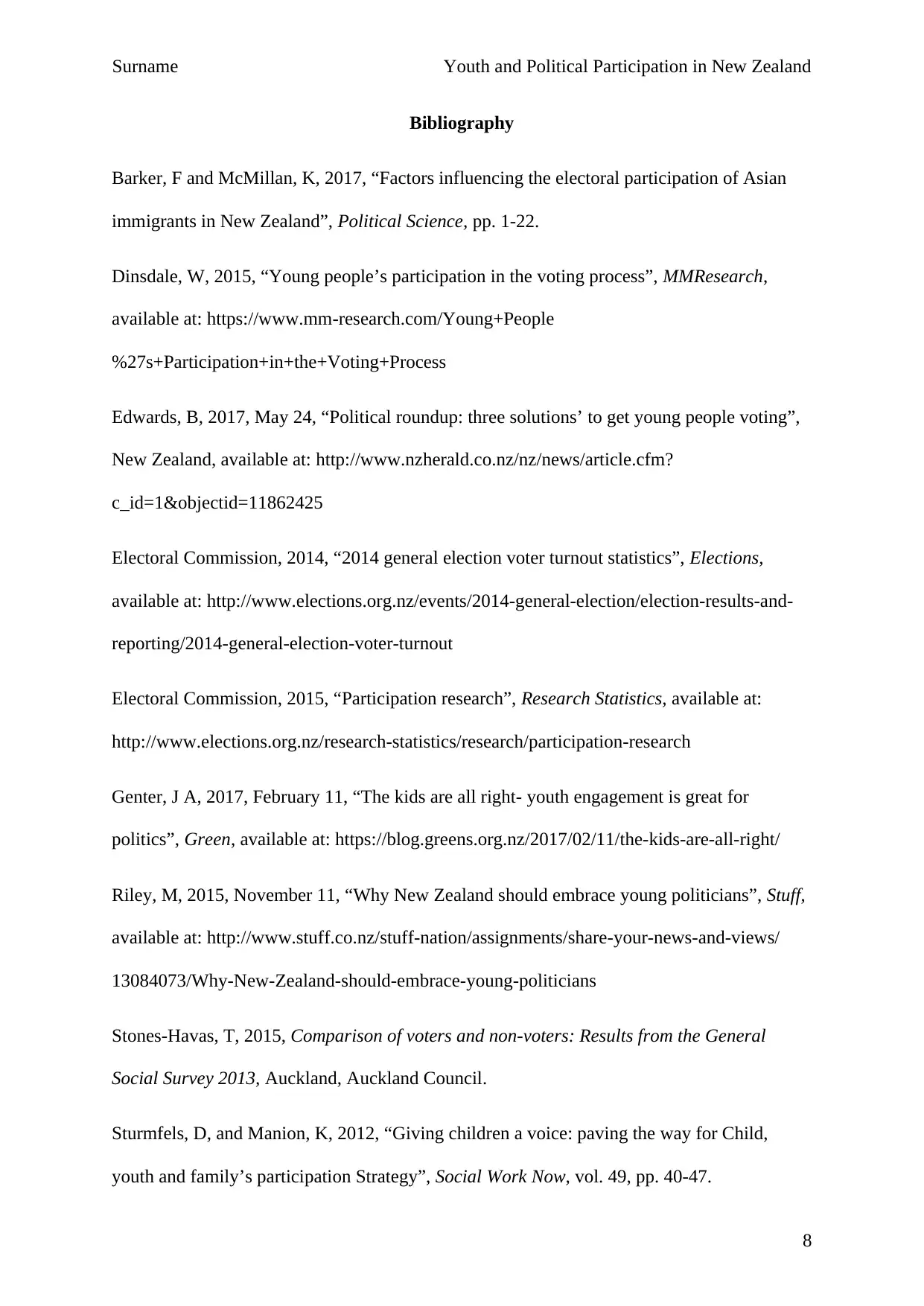
Surname Youth and Political Participation in New Zealand
Bibliography
Barker, F and McMillan, K, 2017, “Factors influencing the electoral participation of Asian
immigrants in New Zealand”, Political Science, pp. 1-22.
Dinsdale, W, 2015, “Young people’s participation in the voting process”, MMResearch,
available at: https://www.mm-research.com/Young+People
%27s+Participation+in+the+Voting+Process
Edwards, B, 2017, May 24, “Political roundup: three solutions’ to get young people voting”,
New Zealand, available at: http://www.nzherald.co.nz/nz/news/article.cfm?
c_id=1&objectid=11862425
Electoral Commission, 2014, “2014 general election voter turnout statistics”, Elections,
available at: http://www.elections.org.nz/events/2014-general-election/election-results-and-
reporting/2014-general-election-voter-turnout
Electoral Commission, 2015, “Participation research”, Research Statistics, available at:
http://www.elections.org.nz/research-statistics/research/participation-research
Genter, J A, 2017, February 11, “The kids are all right- youth engagement is great for
politics”, Green, available at: https://blog.greens.org.nz/2017/02/11/the-kids-are-all-right/
Riley, M, 2015, November 11, “Why New Zealand should embrace young politicians”, Stuff,
available at: http://www.stuff.co.nz/stuff-nation/assignments/share-your-news-and-views/
13084073/Why-New-Zealand-should-embrace-young-politicians
Stones-Havas, T, 2015, Comparison of voters and non-voters: Results from the General
Social Survey 2013, Auckland, Auckland Council.
Sturmfels, D, and Manion, K, 2012, “Giving children a voice: paving the way for Child,
youth and family’s participation Strategy”, Social Work Now, vol. 49, pp. 40-47.
8
Bibliography
Barker, F and McMillan, K, 2017, “Factors influencing the electoral participation of Asian
immigrants in New Zealand”, Political Science, pp. 1-22.
Dinsdale, W, 2015, “Young people’s participation in the voting process”, MMResearch,
available at: https://www.mm-research.com/Young+People
%27s+Participation+in+the+Voting+Process
Edwards, B, 2017, May 24, “Political roundup: three solutions’ to get young people voting”,
New Zealand, available at: http://www.nzherald.co.nz/nz/news/article.cfm?
c_id=1&objectid=11862425
Electoral Commission, 2014, “2014 general election voter turnout statistics”, Elections,
available at: http://www.elections.org.nz/events/2014-general-election/election-results-and-
reporting/2014-general-election-voter-turnout
Electoral Commission, 2015, “Participation research”, Research Statistics, available at:
http://www.elections.org.nz/research-statistics/research/participation-research
Genter, J A, 2017, February 11, “The kids are all right- youth engagement is great for
politics”, Green, available at: https://blog.greens.org.nz/2017/02/11/the-kids-are-all-right/
Riley, M, 2015, November 11, “Why New Zealand should embrace young politicians”, Stuff,
available at: http://www.stuff.co.nz/stuff-nation/assignments/share-your-news-and-views/
13084073/Why-New-Zealand-should-embrace-young-politicians
Stones-Havas, T, 2015, Comparison of voters and non-voters: Results from the General
Social Survey 2013, Auckland, Auckland Council.
Sturmfels, D, and Manion, K, 2012, “Giving children a voice: paving the way for Child,
youth and family’s participation Strategy”, Social Work Now, vol. 49, pp. 40-47.
8
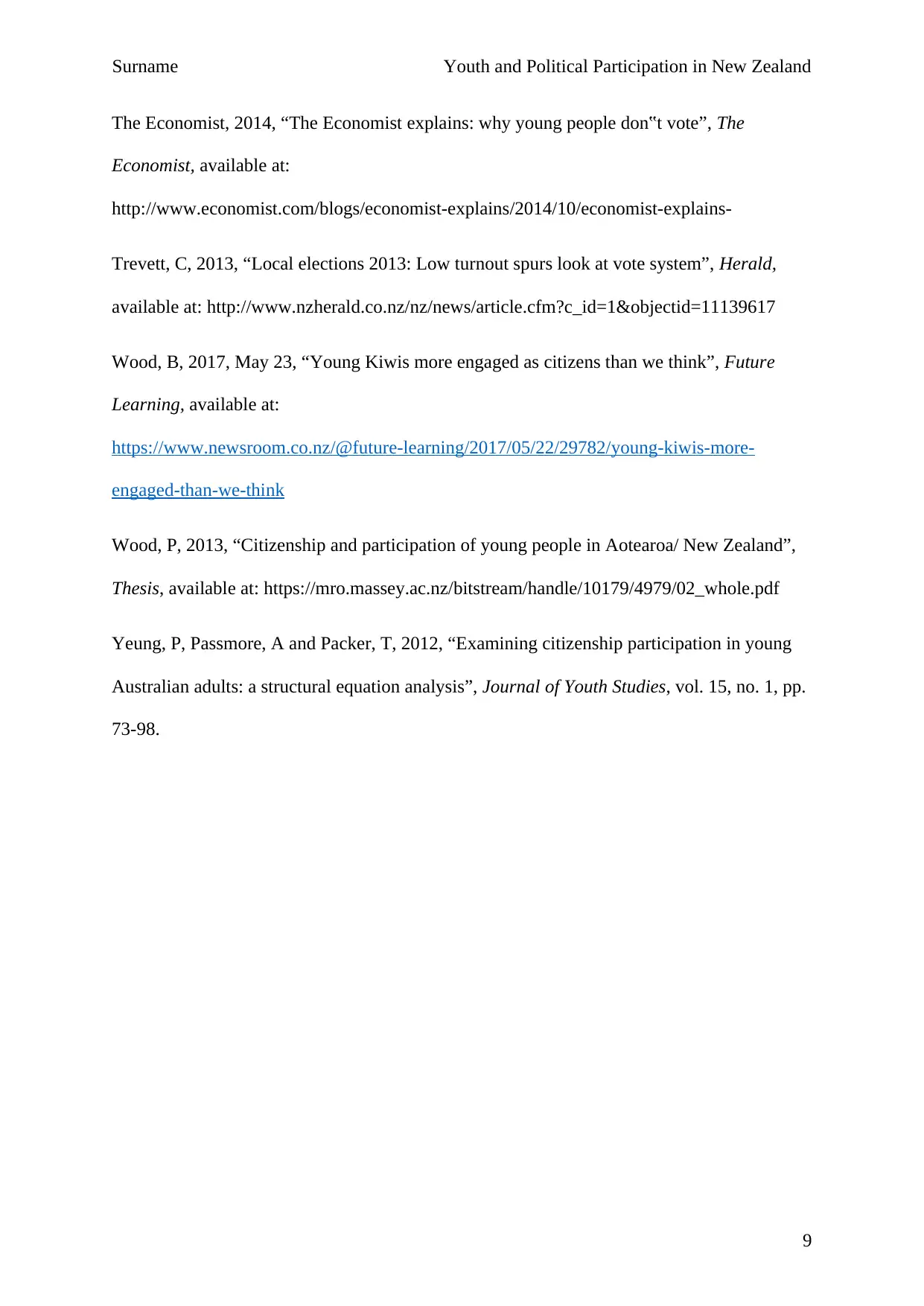
Surname Youth and Political Participation in New Zealand
The Economist, 2014, “The Economist explains: why young people don‟t vote”, The
Economist, available at:
http://www.economist.com/blogs/economist-explains/2014/10/economist-explains-
Trevett, C, 2013, “Local elections 2013: Low turnout spurs look at vote system”, Herald,
available at: http://www.nzherald.co.nz/nz/news/article.cfm?c_id=1&objectid=11139617
Wood, B, 2017, May 23, “Young Kiwis more engaged as citizens than we think”, Future
Learning, available at:
https://www.newsroom.co.nz/@future-learning/2017/05/22/29782/young-kiwis-more-
engaged-than-we-think
Wood, P, 2013, “Citizenship and participation of young people in Aotearoa/ New Zealand”,
Thesis, available at: https://mro.massey.ac.nz/bitstream/handle/10179/4979/02_whole.pdf
Yeung, P, Passmore, A and Packer, T, 2012, “Examining citizenship participation in young
Australian adults: a structural equation analysis”, Journal of Youth Studies, vol. 15, no. 1, pp.
73-98.
9
The Economist, 2014, “The Economist explains: why young people don‟t vote”, The
Economist, available at:
http://www.economist.com/blogs/economist-explains/2014/10/economist-explains-
Trevett, C, 2013, “Local elections 2013: Low turnout spurs look at vote system”, Herald,
available at: http://www.nzherald.co.nz/nz/news/article.cfm?c_id=1&objectid=11139617
Wood, B, 2017, May 23, “Young Kiwis more engaged as citizens than we think”, Future
Learning, available at:
https://www.newsroom.co.nz/@future-learning/2017/05/22/29782/young-kiwis-more-
engaged-than-we-think
Wood, P, 2013, “Citizenship and participation of young people in Aotearoa/ New Zealand”,
Thesis, available at: https://mro.massey.ac.nz/bitstream/handle/10179/4979/02_whole.pdf
Yeung, P, Passmore, A and Packer, T, 2012, “Examining citizenship participation in young
Australian adults: a structural equation analysis”, Journal of Youth Studies, vol. 15, no. 1, pp.
73-98.
9
1 out of 9
Related Documents
Your All-in-One AI-Powered Toolkit for Academic Success.
+13062052269
info@desklib.com
Available 24*7 on WhatsApp / Email
![[object Object]](/_next/static/media/star-bottom.7253800d.svg)
Unlock your academic potential
© 2024 | Zucol Services PVT LTD | All rights reserved.



